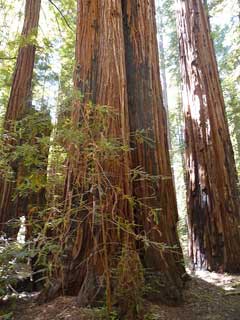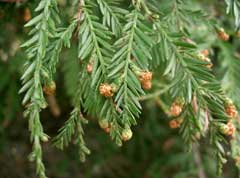 |
|
www.flickr.com/photos/bastique |
 |
| http://commons.wikimedia.org/wiki/User:KENPEI |
Translate this page:
Summary
Form: Pyramidal. Can be misspelt as Sequoia semperviriens
Physical Characteristics

 Taxodium is an evergreen Tree growing to 110 m (361ft) by 20 m (65ft) at a fast rate.
Taxodium is an evergreen Tree growing to 110 m (361ft) by 20 m (65ft) at a fast rate.
See above for USDA hardiness. It is hardy to UK zone 8 and is frost tender. It is in leaf all year, in flower from February to April, and the seeds ripen in October. The species is monoecious (individual flowers are either male or female, but both sexes can be found on the same plant) and is pollinated by Wind.
Suitable for: light (sandy), medium (loamy) and heavy (clay) soils. Suitable pH: mildly acid, neutral and basic (mildly alkaline) soils. It can grow in semi-shade (light woodland) or no shade. It prefers moist soil. It cannot tolerate atmospheric pollution.
UK Hardiness Map
US Hardiness Map
Synonyms
Taxodium sempervirens. Sequoia semperviriens (misspelt)
Plant Habitats
Edible Uses
References More on Edible Uses
Medicinal Uses
Plants For A Future can not take any responsibility for any adverse effects from the use of plants. Always seek advice from a professional before using a plant medicinally.
A poultice of the heated leaves has been used in the treatment of earaches[257]. The gummy sap has been used as a stimulant and tonic in the treatment of rundown conditions[257].
References More on Medicinal Uses
The Bookshop: Edible Plant Books
Our Latest books on Perennial Plants For Food Forests and Permaculture Gardens in paperback or digital formats.

Edible Tropical Plants
Food Forest Plants for Hotter Conditions: 250+ Plants For Tropical Food Forests & Permaculture Gardens.
More

Edible Temperate Plants
Plants for Your Food Forest: 500 Plants for Temperate Food Forests & Permaculture Gardens.
More

More Books
PFAF have eight books available in paperback and digital formats. Browse the shop for more information.
Shop Now
Other Uses
A brown dye is obtained from the bark[168]. The bark and the wood contain tannin, but in too low a concentration for economic utilization[223]. On a 10% moisture basis, the bark contains 4.4% tannin and the wood 2.5%[223]. The sprouts from the burls have been used in making baskets[257]. The plant develops a thick covering of a soft and fibrous bark (you can punch it hard without hurting your hand). This can be harvested without harm to the tree and used as an insulating or stuffing material[171]. A fine bark dust that is produced whilst doing this is a good soil conditioner[171]. This fibrous bark is also used for making paper. Branches can be harvested at any time of the year from logged trees, the bark is cut into useable pieces and soaked in clear water prior to cooking for 6 or more hours with lye. The fibres are beaten for six hours in a ball mill and the paper is a brown colour[189]. Wood - straight-grained, knot-free, light, soft, not strong, very durable in contact with the soil. A high quality and easily worked lumber, it is used for joinery, fence posts, construction etc[1, 11, 46, 61, 82, 171, 229]. Carbon Farming - Industrial Crop: biomass.
Special Uses
References More on Other Uses
Cultivation details
Landscape Uses:Christmas tree, Firewood, Hedge, Aggressive surface roots possible, Screen, Specimen, Woodland garden. Requires a rich moist soil[1], growing best in deep sheltered valleys in cool humid areas[81, 200]. Dislikes chalky soils according to one report[1] whilst another says that it succeeds on chalk[200]. Tolerates poorly drained sites[200]. Tolerates partial shade for many years when young[200]. Strongly dislikes windy sites, especially if the winds are cold[200]. Plants dislike atmospheric pollution, growing poorly in cities[185]. Plants are fully hardy in Britain, though they may lose their leaves in cold winters. This seems to have no detrimental effect on the tree[188]. The giant redwood is probably the tallest growing tree in the world[11, 81], it thrives in Britain, especially in the cooler moister western half of the country[11]. It is fast growing in cultivation[81], reaching 25 metres tall in 20 years in a good site[200], and can be successfully coppiced even when quite old[11, 81, 200]. It is a long-lived tree in the wild, often living 1000 years and with some specimens 2200 years old recorded[229]. Plants are tender when young[11]. If trees larger than 80cm are planted out, they should be coppiced in order to allow the roots to become established[200]. Male cones shed their pollen in February unless delayed by frost when they might wait until April. Frost just before flowering or at the time of flowering kills the pollen[185]. New growth takes place from May until the end of September and can be very vigorous, 1.2 metres a year is not uncommon and this can be maintained for 30 years or more[185]. The best trees are found in Devon, Wiltshire, Perthshire and Ireland[185]. The crushed foliage has the scent of candle wax[185]. Special Features:
Attracts birds, North American native, Inconspicuous flowers or blooms. Carbon Farming - Climate: warm temperate to subtropical, tropical highlands. Humidity: humid. Cultivation: minor global crop. Management: coppice.
References Carbon Farming Information and Carbon Sequestration Information
Temperature Converter
Type a value in the Celsius field to convert the value to Fahrenheit:
Fahrenheit:
The PFAF Bookshop
Plants For A Future have a number of books available in paperback and digital form. Book titles include Edible Plants, Edible Perennials, Edible Trees,Edible Shrubs, Woodland Gardening, and Temperate Food Forest Plants. Our new book is Food Forest Plants For Hotter Conditions (Tropical and Sub-Tropical).
Shop Now
Plant Propagation
Seed - sow early spring in a cold frame in light shade. Seed can also be sown as soon as it is ripe in a greenhouse. Germination rates are usually very low[11]. Prick out the seedlings into individual pots once they are large enough to handle and grow them on in a cold frame for their first winter, planting them out into their permanent positions in late spring or early summer. Plants will require some protection from the cold and spring frosts for their first year or two outdoors[78]. If there are sufficient seeds, they can be sown in a lightly shaded outdoor bed in late March[78]. Grow on the plants in the seedbed for two years before planting them out into their permanent positions in late autumn or early spring. Cuttings of half-ripe wood, August/September in a frame. They form roots in winter or early spring[1]. Pot them up into individual pots once the roots are developing nicely and plant them out in the summer if they are growing well. Otherwise grow them on for the next winter in a cold frame and plant them out in early summer.
Other Names
If available other names are mentioned here
Native Range
NORTHERN AMERICA: United States (Oregon (s.w. (sw Curry Co.)), California (n.w. & w.-c.))
Weed Potential
Right plant wrong place. We are currently updating this section.
Please note that a plant may be invasive in one area but may not in your area so it's worth checking.
Conservation Status
IUCN Red List of Threatened Plants Status :

Growth: S = slow M = medium F = fast. Soil: L = light (sandy) M = medium H = heavy (clay). pH: A = acid N = neutral B = basic (alkaline). Shade: F = full shade S = semi-shade N = no shade. Moisture: D = dry M = Moist We = wet Wa = water.
Now available:
Food Forest Plants for Mediterranean Conditions
350+ Perennial Plants For Mediterranean and Drier Food Forests and Permaculture Gardens.
[Paperback and eBook]
This is the third in Plants For A Future's series of plant guides for food forests tailored to
specific climate zones. Following volumes on temperate and tropical ecosystems, this book focuses
on species suited to Mediterranean conditions—regions with hot, dry summers and cool, wet winters,
often facing the added challenge of climate change.
Read More
Expert comment
Author
(D.Don.)Endl.
Botanical References
1171200
Links / References
For a list of references used on this page please go here
Readers comment
| Add a comment |
|
If you have important information about this plant that may help other users please add a comment or link below. Only comments or links that are felt to be directly relevant to a plant will be included. If you think a comment/link or information contained on this page is inaccurate or misleading we would welcome your feedback at [email protected]. If you have questions about a plant please use the Forum on this website as we do not have the resources to answer questions ourselves.
* Please note: the comments by website users are not necessarily those held by PFAF and may give misleading or inaccurate information.
To leave a comment please Register or login here All comments need to be approved so will not appear immediately.
|
|